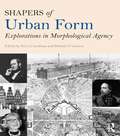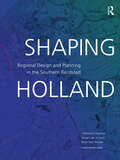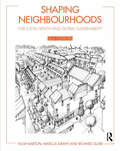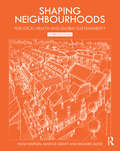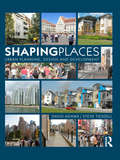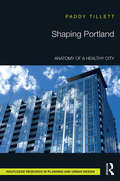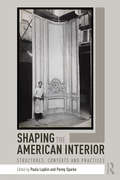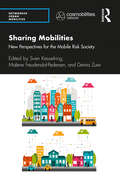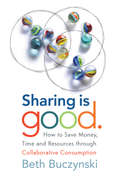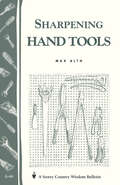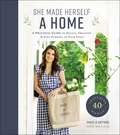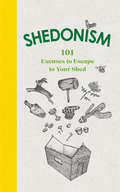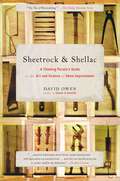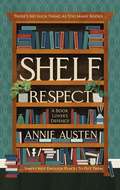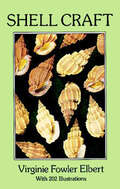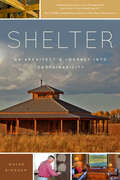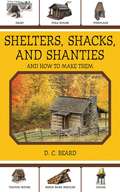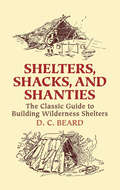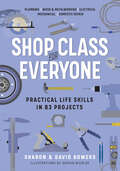- Table View
- List View
Shapers of Urban Form: Explorations in Morphological Agency
by Peter J. Larkham Michael P. ConzenPeople have designed cities long before there were urban designers. In Shapers of Urban Form, Peter Larkham and Michael Conzen have commissioned new scholarship on the forces, people, and institutions that have shaped cities from the Middle Ages to the present day. Larkham and Conzen collect new essays in "urban morphology," the people-centered predecessor to contemporary theories of top-down urban design. Shapers of Urban Form focuses on the social processes that create patterns of urban forms in four discrete periods: Pre-modern, early modern, industrial-era and postmodern development. Featuring studies of English, American, Western and Eastern European, and New Zealand urban history and urban form, this collection is invaluable to scholars of urban design and town planning, as well as urban and economic historians.
Shaping Holland: Regional Design and Planning in the Southern Randstad
by Jeroen van Schaick Francisco Colombo Peter WitsenAll around the world, regions are facing major challenges: climate change, the transition to renewable energy, reinventing the food system, ongoing urbanisation and finding room to sustain biodiversity. These will radically transform our living and working environments. Regional design uses the power of visualisation to unite regional players around appealing spatial development visions for meeting those challenges. It offers a route to new forms of regional governance and planning that match the urgencies of our time. This book exposes the benefits and the pitfalls of regional plans and designs. Shaping Holland gives a unique insight into the emergence of contemporary regional planning and design practice in the Netherlands. This densely populated country in the delta of the Rhine and Meuse rivers is internationally renowned for its urban planning and design tradition. Drawing on first-hand accounts and a rich collection of illustrations, maps and diagrams, the book gives pointers for practitioners, academics and students of spatial planning, urban design and landscape architecture. Regional design is on the rise in all continents. It provides an answer to a world in which economic activities, activity patterns, urban growth and ecological systems are no respecters of administrative boundaries. Amid the growing number of academic analyses of regional design, this book is unique because it focuses on planning practice and first-hand knowledge. As such it is of interest to a broad international readership.
Shaping Neighbourhoods: For Local Health and Global Sustainability
by Hugh Barton Marcus Grant Richard GuiseThis substantially revised and important second edition comes at a pivotal time, with both a strong agenda of localism in planning and with public health professionals now realising the vital importance of shaping urban environments in order to reduce the burden of disease and support better health outcomes. This guide ensures you: understand the underlying principles for planning healthy and sustainable neighbourhoods and towns plan the collaborative and inclusive processes needed for multi-sectoral cooperation develop know-how and skills in matching local need with urban form discover new ways to integrate development with natural systems design places with character and recognise good urban form guide communities, and advise developers, in the creation of successful and sustainable places for living. Containing many new case studies and a wealth of new research, this new edition has benefited from previous user feedback. Shaping Neighbourhoods is the indispensable guide for bridging the gulf between theory and practice, between planning authorities, investors and communities, and between different professional perspectives. Whether you are a student faced with a local planning project; a planner, urban designer or developer involved in new development; a health authority concerned with promoting physical activity; or a community group wanting to improve your neighbourhood; this book is for you.
Shaping Neighbourhoods: For Local Health and Global Sustainability
by Hugh Barton Marcus Grant Richard GuiseShaping Neighbourhoods is unique in combining all aspects of the spatial planning of neighbourhoods and towns whilst emphasising positive outcomes for people’s health and global sustainability. This new edition retains the combination of radicalism, evidence-based advice and pragmatism that made earlier editions so popular. This updated edition strengthens guidance in relation to climate change and biodiversity, tackling crises of population health that are pushing up health-care budgets, but have elements of their origins in poor place spatial planning – such as isolation, lack of everyday physical activity, and respiratory problems. It is underpinned by new research into how people use their localities, and the best way to achieve inclusive, healthy, low-carbon settlements. The guide can assist with: • Understanding the principles for planning healthy and sustainable neighbourhoods and towns • Planning collaborative and inclusive processes for multi-sectoral working • Developing know-how and skills in matching local need with urban form • Discovering new ways to integrate development with natural systems • Designing places with character and recognising good urban form Whether you are a student faced with a local planning project; a public health professional, planner, urban designer or developer involved in new development or regeneration; a council concerned with promoting healthy and sustainable environments; or a community group wanting to improve your neighbourhood – you will find help here.
Shaping Places: Urban Planning, Design and Development
by David Adams Steve TiesdellShaping Places explains how towns and cities can turn real estate development to their advantage to create the kind of places where people want to live, work, relax and invest. It contends that the production of quality places which enhance economic prosperity, social cohesion and environmental sustainability require a transformation of market outcomes. The core of the book explores why this is essential, and how it can be delivered, by linking a clear vision for the future with the necessary means to achieve it. Crucially, the book argues that public authorities should seek to shape, regulate and stimulate real estate development so that developers, landowners and funders see real benefit in creating better places. Key to this is seeing planners as market actors, whose potential to shape the built environment depends on their capacity to understand and transform the embedded attitudes and practices of other market actors. This requires planners to be skilled in understanding the political economy of real estate development and successful in changing its outcomes through smart intervention. Drawing on a strong theoretical framework, the book reveals how the future of places will come to be shaped through constant interaction between State and market power. Filled with international examples, essential case studies, color diagrams and photographs, this is essential reading for undergraduate and graduate students taking planning, property, real estate or urban design courses as well as for social science students more widely who wish to know how the shaping of place really occurs.
Shaping Portland: Anatomy of a Healthy City
by Paddy TillettPortland is a young city founded on a river bank in a virgin forest less than 200 years ago. Shaping Portland: Anatomy of a Healthy City is about the values engendered by the place, and how those values have influenced the growing city. It examines how and why the public realm supports or obstructs the health-forward lifestyles of those who choose to live there. This book explores the values and dynamics that shaped a healthy city to enable those things. It is a case study of a recognized success – looking more closely at a recent urban infill: the Pearl District. The future roles of the planners and other design professionals in continuing to build healthy and responsive environments are suggested. The cities of the future will be those that we already inhabit, but infilled and adapted to tomorrow’s needs and values. Understanding the dynamics involved is essential for those in whose hands we entrust the design of cities and urban places.
Shaping the American Interior: Structures, Contexts and Practices
by Penny Sparke Paula LupkinBringing together 12 original essays, Shaping the American Interior maps out, for the first time, the development and definition of the field of interiors in the United States in the period from 1870 until 1960. Its interdisciplinary approach encompasses a broad range of people, contexts, and practices, revealing the design of the interior as a collaborative modern enterprise comprising art, design, manufacture, commerce, and identity construction. Rooted in the expansion of mass production and consumption in the last years of the nineteenth century, new and diverse structures came to define the field and provide formal and informal contexts for design work. Intertwined with, but distinct from, architecture and merchandising, interiors encompassed a diffuse range of individuals, institutions, and organizations engaged in the definition of identity, the development of expertise, and the promotion of consumption. This volume investigates the fluid pre-history of the American profession of interior design, charting attempts to commoditize taste, shape modern conceptions of gender and professionalism, define expertise and authority through principles and standards, marry art with industry and commerce, and shape mass culture in the United States.
Shaping the City: Studies in History, Theory and Urban Design
by Rodolphe El-Khoury Edward RobbinsTaking on the key issues in urban design, Shaping the City examines the critical ideas that have driven these themes and debates through a study of particular cities at important periods in their development. As well as retaining crucial discussions about cities such as Los Angeles, Atlanta, Chicago, Detroit, Philadelphia, and Brasilia at particular moments in their history that exemplified the problems and themes at hand like the mega-city, the post-colonial city and New Urbanism, in this new edition the editors have introduced new case studies critical to any study of contemporary urbanism – China, Dubai, Tijuana and the wider issues of informal cities in the Global South. The book serves as both a textbook for classes in urban design, planning and theory and is also attractive to the increasing interest in urbanism by scholars in other fields. Shaping the City provides an essential overview of the range and variety of urbanisms and urban issues that are critical to an understanding of contemporary urbanism.
Sharing Mobilities: New Perspectives for the Mobile Risk Society (Networked Urban Mobilities Series)
by Dennis Zuev Sven Kesselring Malene Freudendal-PedersenSharing Mobilities focuses on the emergence of future sustainable and collaborative mobility cultures. At the intersection of physical and virtual capacity and access to people, goods, ideas, and services, this book poses fundamental challenges and opportunities for governance, economy, planning, and identity. The future of new collaborative forms of consumption and sharing would play a key role in the organization of everyday life and business. Sharing mobilities is more than simply sharing transport, and its diverse impacts on society and the environment demand thorough theory-led sociological research. With an extensive global range, the contributors present radical manifestations of sharing capacities throughout diverse countries, including Germany, Denmark, Japan, and Vietnam. The phenomenon of mobility is highly actual and social as well as politically relevant and urging. This collection focuses on open questions from the perspective of the mobilities turn while presenting state-of-the-art theory-based articles with applied perspectives. An ideal read for scholars based in social science and the interdisciplinary research on mobility, transports, and sharing economy. Sociologists, geographers, economists, urban governance researchers, and research students would also find this book of interest.
Sharing is Good
by Beth BuczynskiCollaborative consumption is a new way of living in which access is valued above ownership, experience is prized over material possessions, and "mine" becomes "ours," allowing everyone's needs to be met with minimum waste. Bursting at the seams with hundreds of helpful tips and valuable resources, Sharing is Good is a practical guide to this new and exciting "sharing economy."
Sharp: The Definitive Guide to Knives, Knife Care, and Cutting Techniques, with Recipes from Great Chefs
by Josh Donald Molly DeCoudreauxSharp is a knife skills class in book form and an introduction to the best knives you can buy from all over the world. From a premier knife purveyor and go-to knives expert, this comprehensive guide details the elements of buying and caring for good knives, including sharpening and knife skills. Step-by-step instructions and photography cover a range of techniques with 15 recipes from great chefs—including Stuart Brioza of State Bird Provisions and Melissa Perello of Frances—which feature all the cuts that mark an accomplished cook. Sharply packaged with a textured cover, a foil spine, and more than 150 striking photographs of knifemakers, coveted knives, and beautiful food, this is the cookbook, handbook, and visual journey for anyone wanting to hone their skills in the kitchen.
Sharpening Hand Tools: Storey's Country Wisdom Bulletin A-66
by Max AlthSince 1973, Storey's Country Wisdom Bulletins have offered practical, hands-on instructions designed to help readers master dozens of country living skills quickly and easily. There are now more than 170 titles in this series, and their remarkable popularity reflects the common desire of country and city dwellers alike to cultivate personal independence in everyday life.
She Made Herself a Home: A Practical Guide to Design, Organize, and Give Purpose to Your Space
by Rachel Van KluyveLearn how to create a home that's inviting, beautiful, and uniquely you--all while staying on a budget. Whether you're decorating your first home, planning for renovations, or simply looking for an affordable refresh, She Made Herself a Home is the ideal home décor planner to help you tap into your creative side and instill the confidence you need to get started on those DIY projects. Popular blogger Rachel Van Kluyve of Crate & Cottage, along with a community of other successful home décor bloggers, offers up simple design tips for those who want to create lovely, budget-friendly, intentional spaces for themselves and their families.In She Made Herself a Home, Rachel will:Walk readers through a style quiz to determine if their style is modern, traditional, rustic, or eclecticGuide readers through selecting a color schemeProvide the best tips for choosing the right item(s) for your spaceGive insight on how to find great dealsOffer easy-to-follow organization tips for every roomWith ideas adaptable to any décor style, readers will learn:Must-have items for each roomEasy steps to determine a layout that works for each individual's homeHow to determine the unique purpose of each spaceSimple DIY tactics to customize each spaceYou don't have to break the bank to bring new life and purpose into your home. With design expertise from Rachel and others, you can confidently take action to create the beautiful, peaceful home you've dreamed of.
She Sheds Style: Make Your Space Your Own
by Erika Kotite“A charming primer . . . Part practical decorating handbook and part empowerment guide for women, this book on mini-scaled spaces is full-scale fun.” —Publishers WeeklyIt’s no secret that the she shed revolution is underway and gaining steam. What is a she shed? It’s simply any outbuilding that has been renovated, outfitted, redesigned, or otherwise reassigned into service as a refuge from the intense pace of modern life. Consider it a woman’s response to the “man cave” craze.Whether you already have that sought-after shed or are still in the dreaming phase, home and lifestyle expert Erika Kotite—author of the bestselling She Sheds: A Room of Your Own—will help you on your journey.Browse gorgeous photos of a variety of sheds and shed interiors, which range from modern and eclectic to rustic and shabby chic.Learn what architectural details play into a shed’s look and consider how these elements work with your preferred decor.Explore dozens of DIY projects: breathe new life into old furniture, install a track door, or craft a custom neon sign for your shed.Find hundreds of tips and ideas from some of the most creative she shed owners around the world.A variety of front entrance ideas provide inspiration for welcoming guests to your space. Ideas for repurposing furniture abound, such as transforming an old door into a drop-down potting bench. You can even extend your shed’s impact beyond the walls with garden features like stepping stones and string lights. Most projects are shown with detailed, step-by-step photos so you can see exactly how the work is done.So get started and create your own she shed style!
Shedonism: 101 Excuses to Escape to Your Shed
by Ben WilliamsFind yourself, in your shed.Turn your she-shed or man cave into your own private escape with 101 simple, practical ideas.Take some well-deserved alone time and learn to preserve lemons and chillies, whittle a butter knife, tie your own fishing flies, keep chickens, plant a roof garden or make a camera obscura.Why not transform your shed itself? This book is full of inspiration for anyone who has dreamed of having an observatory, a sauna, a pub – or just a bit of peace and quiet at the bottom of the garden.The perfect gift for anyone who would rather be in their shed.
Sheetrock & Shellac: A Thinking Person's Guide to the Art and Science of Home Improvement
by David OwenIn a world of extreme makeovers, this book is a thoughtful, adventure-filled, witty look at what the space we live in says about us, the pleasures of home renovation projects great and small, and how home renovation can change our lives. Few things define us as powerfully as the place where we live. The size and location of a house may reveal basic facts about our financial or social status, but it is the personal touches -- a paint color or a homemade desk -- that reflect our aspirations, our tastes, our secret desires. In Sheetrock & Shellac, David Owen recounts his renovation and home construction projects in small-town Connecticut -- from catching the home improvement bug while watching workmen replacing a leaky roof to his first tentative foray into DIY (successfully building an enclosure for a bathroom radiator that had "turned into a sort of low-tech factory for converting splattered urine into odor and dust"). As his skill grows, so does his confidence: replacing a broken light switch turns into wiring an entire room, making bookcases is followed by building an office. Some of the more overly imaginative projects -- for instance, an ambition to install sinks and hot and cold faucets in all the rooms of the house -- never come to fruition but are amusingly recounted for other intrepid home designers. Owen's two-hundred-year-old farmhouse provides numerous occasions for home improvement projects, and layers (literally) of fascination. Owen quickly learns the hard way when to tackle a project himself and when to turn for help. But soon he's so comfortable with the undertaking that he decides to take the big leap from renovation to building a completely new home from the ground up. In this case, Owen decides to build a weekend cabin a mere six miles away from his home. From a discourse on kitchen countertop materials to the complete history of concrete, to a near-disastrous mishap with a tree, a newly constructed roof, and an overzealous chainsaw, Owen's journey through home designing and building proves both enthrallingly educating and hilariously detailed. New Yorker writer Owen's engaging narrative, filled with a wealth of practical information, hands-on tips, and canny insights, explores the ways in which the human processes of construction and renovation leave all the parties transformed. More than a simple how-to, Sheetrock & Shellac is a why-to, a wellspring of savvy advice and encouragement for anyone who has ever contemplated changing their surroundings and changing their life.
Shelf Respect: A Book Lovers' Guide to Curating Book Shelves at Home
by Annie AustenDecluttering is all the rage, but what do you do when your preferred style of interior decor is miles of overstuffed bookshelves? If you can't bring yourself to KonMari your collection, SHELF RESPECT will validate your life choices.The perfect gift for the book lover in your life: a celebration of the humble but oh-so-wonderful bookshelf. Do you alphabetise your books or organise by genre... or (heaven forbid) colour? Have you merged your collection with your other half's? (And do you write your name inside the cover, just in case?) Do you keep all the books you've read, or only the most cherished? (Is there such a thing as too many books?) Are you a Billy aficionado, or are we talking library ladders and bespoke Oak shelves? Bound to provoke (good-natured) debate between Bibliophiles, SHELF RESPECT is a charmingly illustrated book in defence of towering TBR piles and overflowing shelves... no matter how you choose to organise them.And whilst you #StayHome, don't miss these other great titles from Sphere Books: ** Distract Yourself: 101 Positive Things to Do and Learn Whilst You Stay Home ** ** The Bumper Book of Would You Rather? Over 350 hilarious hypothetical questions for ages 6 to 106 **** Home Sweet Home: The Little Book of Natural Cleaning **** AA British Road Map Puzzle Book: Addictive map-based brain-games for anyone in lockdown **
Shelf Respect: A Book Lovers' Guide to Curating Book Shelves at Home
by Annie AustenDecluttering is all the rage, but what do you do when your preferred style of interior decor is miles of overstuffed bookshelves? If you can't bring yourself to KonMari your collection, SHELF RESPECT will validate your life choices.The perfect gift for the book lover in your life: a celebration of the humble but oh-so-wonderful bookshelf. Do you alphabetise your books or organise by genre... or (heaven forbid) colour? Have you merged your collection with your other half's? (And do you write your name inside the cover, just in case?) Do you keep all the books you've read, or only the most cherished? (Is there such a thing as too many books?) Are you a Billy aficionado, or are we talking library ladders and bespoke Oak shelves? Bound to provoke (good-natured) debate between Bibliophiles, SHELF RESPECT is a charmingly illustrated book in defence of towering TBR piles and overflowing shelves... no matter how you choose to organise them.And whilst you #StayHome, don't miss these other great titles from Sphere Books: ** Distract Yourself: 101 Positive Things to Do and Learn Whilst You Stay Home **** The Bumper Book of Would You Rather? Over 350 hilarious hypothetical questions for ages 6 to 106 **** Home Sweet Home: The Little Book of Natural Cleaning **** AA British Road Map Puzzle Book: Addictive map-based brain-games for anyone in lockdown **
Shelfie: Clutter-clearing ideas for stylish shelf art
by Martha RobertsA decorating trend and social media phenomenon, 'the shelfie' originally emerged in response to the clutter-clearing movement. What started as a label for beautiful bookshelves is now applied to artfully stylish arrangements of collectables, flowers, photos, crafting ephemera, perfume bottles - and of course books. And shelfies don't just appear on shelves, but also on desks, worktops and fireplaces.De-cluttering, and then curating our favourite possessions stylishly, is a great way to bring personality into the home and workspace. In the first book on the shelfie, Martha Roberts shows you how to source, sort and arrange your belongings for every room in the house. Photography by Nick Pope, who took the photographs for At Home with Plants, also published by Mitchell Beazley.'While most of us are just beginning to get to grips with the selfie, the 'shelfie' movement has been gaining digital ground. The self-obsessed are becoming the 'shelf-obsessed.' - Talib Choudry, the Telegraph
Shell Craft
by Virginie Fowler ElbertSince ancient times, seashells have provided both materials and design inspiration for a variety of arts and crafts. Shell-inspired motifs have turned up in pottery and floor mosaics, as architectural ornaments, and on furniture. The magnificent mollusks have also been used as money and decorative objects to adorn the body. This comprehensive guide by Virginie Fowler Elbert -- noted author, crafter, and authority on shell lore -- offers a wealth of craft ideas for using these lovely treasures from the sea.Following a fascinating introduction to the use of shells throughout history, the simply written text provides step-by-step instructions for cleaning, preparing, and displaying shells; suggests methods for decorating boxes and mirror frames; and shows how to create fanciful soap dishes, night lights, and jewelry items -- from pendants and necklaces to bracelets, cuff links, and earrings.You'll also find easy-to-follow directions for preserving shells in resin to make paperweights, napkin holders, cachepots, and other household accessories, as well as instructions for casting shell forms from molds (an ideal way to develop multiple patterns if only a few shells are available). There's even a chapter on how to do shell printing with linoleum blocks and crayon prints to create distinctive designs for placemats, wall hangings, wrapping paper, and stationery. Reference works and an updated list of supply sources round out this profusely illustrated guide to a fun-filled and rewarding pastime.
Shelter: An Architect's Journey into Sustainability
by Wayne BinghamAfter practicing conventional glass, steel, and concrete architecture for more than thirty years, an award-winning architect discovers the concept of sustainable living and embarks on a journey that ends with his own strawbale home at the foot of the Grand Tetons. A complete source of information for sustainable and off-the-grid construction, Shelter explores the principles of sustainable living and then illustrates actual execution of those principles in the author's strawbale home. Both an exploration of sustainability from an architect's point of view as well as a practical reference for home builders, Shelter is an indispensable resource to those interested in leaving a smaller foot print on the environment. Follow the author from the beginning idea through the planning, designing, and constructing to the realities of living in his strawbale dream home.
Shelters, Shacks, and Shanties: And How to Make Them (Lyons Press Ser.)
by Daniel Carter BeardNineteenth-century building advice that is eminently practical in the twenty-first century. 330 b/w illustrations
Shelters, Shacks, and Shanties: The Classic Guide to Building Wilderness Shelters
by D. C. BeardThis excellent hands-on guide by one of the founders of the Boy Scouts of America contains a wealth of practical instruction and advice on how to build everything from a bark teepee and a tree-top house to a log cabin and a sod house. No professional architects are needed here; and knowing how to use an axe is more important than possessing carpentry skills. More than 300 of the author's own illustrations and a clear, easy-to-follow text enable campers to create such lodgings as half-cave shelters, beaver mat huts, birch bark shacks, over-water camps, a Navajo hogan, and a pole house. <p><p> Additional chapters provide information on how to use an axe, split and notch logs, make a fireplace, and even build appropriate gateways to log houses, game preserves, ranches, and other open areas. An invaluable book for scouts, campers, hikers, and hunters of all ages, this guide and its fascinating collection of outdoor lore "still has intrinsic value," said Whole Earth Magazine, and will be of keen interest to any modern homesteader.
Sheridan Nurseries: One Hundred Years of People, Plans, and Plants
by Edward Butts Karl StenssonA charming tale of history, creativity, natural inspiration, and a love of gardening. In 1913, Howard Dunington-Grubb and his wife, Lorrie, bought a small plot of land near Sheridan, Ontario, for the cultivation of ornamental plants. Local farmers thought they were crazy. But Howard and Lorrie, landscape architects recently arrived from England, were visionaries who dreamed of creating magnificent gardens in the colonial wasteland. Realizing that Canada had no nurseries that produced the plants they needed, they started one of their own. To manage it they hired Herman Stensson, an expert nurseryman whose references included one from the crown prince of Denmark.The chronicles of the Dunington-Grubbs and the Stensson family form the basis for the incredible history of Sheridan Nurseries, enhanced by the diverse backgrounds and experiences of the many people who helped turn a dream into success. This Canadian saga reaches from the monuments of Toronto’s University Avenue and Niagara’s Oakes Garden Theatre to hundreds of parks and estates, and perhaps even your own backyard.
Shop Class for Everyone: Plumbing · Wood & Metalwork · Electrical · Mechanical · Domestic Repair
by David Bowers Sharon BowersDid you remember your goggles?There used to be a time when pretty much every high school offered Shop class, where students learned to use a circular saw or rewire a busted lamp- all while discovering the satisfaction of being self-reliant and doing it yourself. Shop Class for Everyone now offers anyone who might have missed this vital class a crash course in these practical life skills. Packed with illustrated step by step instructions, plus relevant charts, lists, and handy graphics, here&’s how to plaster a wall, build a bookcase from scratch, unclog a drain, and change a flat tire (on your car or bike). It&’s all made clear in plain, nontechnical language for any level of DIYer, and it comes with a guarantee: No matter how simple the task, doing it with your own two hands provides a feeling of accomplishment that no app or device will ever give you.
